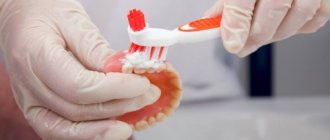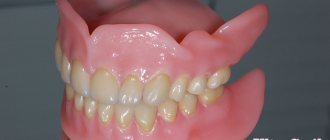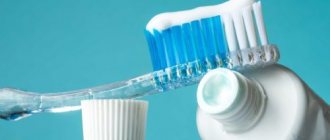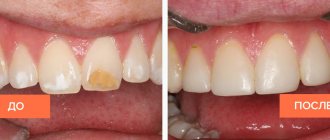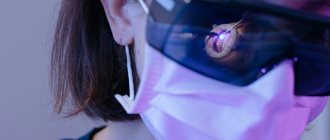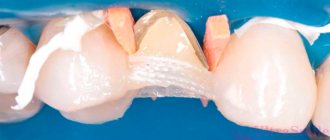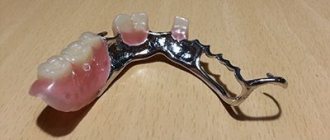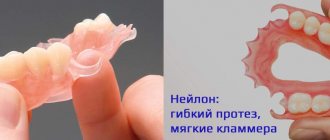Fixed dentures - features and advantages
Fixed dentures are considered the most effective and inexpensive solution to restore dentition.
The most common causes of tooth decay and subsequent loss are:
- abundant carious lesions;
- pulpitis;
- periodontitis;
- dental cysts, etc.
As a result of these dental diseases, tooth crowns and roots are destroyed, teeth fall out on their own, or surgical intervention is required to remove dead hard tissues and roots. For restoration, the dentist recommends permanent dental prosthetics, the basis of which is a bridge and ceramic crowns of the latest generation.
Advantages of fixed dentures:
- Aesthetics. Fixed dentures are difficult to distinguish from your teeth. With proper selection and proper installation, the design looks harmonious in the oral cavity, and the person smiles boldly.
- Comfort. A person quickly gets used to a fixed denture and does not feel discomfort afterwards.
- There is no need to build up bone for high-quality implementation of a fixed denture. When using modern artificial roots, there is often no need to build up bone tissue. This simplifies the entire dental procedure and makes it much more affordable.
- Fast payback. The investment in fixed dentures always pays off in dental health, attractive visual effect and durability.
Methods for fixing dentures in the absence of teeth
Keeping a removable laminar denture in the mouth at rest occurs due to a combination of several factors:
- Adhesion (sticking, adhesion)
. If there is a wet layer, 2 touching objects stick to each other. Moisture is provided by saliva. Its viscosity reduces or increases adhesion. However, this force alone is not enough to hold the structure. - Anatomical retention
. Protruding parts of the oral cavity limit the movement of the restoration. With significant bone loss, retention is significantly reduced. - Valve fixation
. When put on, the prosthesis slightly presses the mucous membrane, displacing air from under the base. The mucous membrane returns to its shape and does not allow air to flow back. A vacuum is formed. Due to the difference in pressure, the restoration is suctioned.
This is the main way that upper dentures are held in place. With lower structures the situation is more complicated. To fix them, you often have to resort to additional means.
The main types of permanent dental crowns
At the stage of planning treatment with a fixed denture, the dentist, together with the patient, decides which type of fixed dental crown to use for high-quality prosthetics.
Currently, the most common fixed dentures are:
- Teeth crowns
They are used if the hard tissues of your tooth are destroyed by more than 2/3. The implementation of this type of fixed dental prosthetics occurs as follows:
- the tooth is strengthened with a supporting core and a fiberglass dental pin;
- the tooth is ground down;
- the dentist makes impressions of the tooth;
- After a week or two, a ceramic crown or one made of metal ceramics, plastic, zirconium dioxide, etc. “sits” on your tooth.
- a person receives a new healthy tooth that does not differ from his own either visually or in functional characteristics.
- Veneers – as a type of fixed denture
- their teeth are prepared;
- a thin ceramic onlay is fixed on the surface of pre-selected teeth;
- within a few hours the patient receives an impeccable effect - even, snow-white and beautiful teeth.
A veneer is a thin ceramic inlay that perfectly matches the shape, color, and transparency of your tooth. Such a fixed denture “sits” with the help of a special dental glue on the front wall of a previously ground tooth. Recently, super-thin permanent dental veneers have appeared, which practically do not require grinding of their crown, do not stick out, and look organic. As a rule, veneers are placed on the front six to ten teeth of the upper jaw (smile area). If the lower teeth are in good condition, whitening them is enough to achieve the ideal effect.
Installation of fixed dentures and veneers occurs as follows:
The average lifespan of veneers with proper use is up to 10 years.
Restoring ceramic inlays are used when more than ½ of the tooth crown is destroyed. Dental micro dentures are made from individual dental impressions in dental laboratories, fixed using a special dental bond, and prevent the occurrence of recurrent caries on the teeth.
Advantages of ceramic inlays (mini dentures) compared to composite fillings:
- high strength;
- durability of teeth (on average, from 3 years);
- ceramic systems do not absorb pigments and do not darken;
- retain their qualities throughout the entire period of validity.
Stages of orthopedic installation removal
The process of dismantling a fixed prosthesis consists of the following steps:
- preparation: an orthopedic dentist examines the patient’s entire oral cavity and the problem area in particular, assesses their condition and comes up with a work plan,
- removal: the doctor and the patient decide on the method and the crown is dismantled,
- diagnostics: the doctor evaluates the integrity of the removed installation, and also carefully examines the condition of the tooth root on which the detached structure was supported. The place for subsequent fixation of the prosthesis is treated with antiseptics (and if necessary, therapeutic measures are carried out, during which the patient is given a temporary plastic crown),
- fixation: if the prosthesis was not deformed during removal, it is ready for reinstallation. Otherwise, you will have to wait until it is restored or a new crown is made. True, you will have to carry out several fittings and be sure to take into account the shape of the treated tooth - it is important that it completely coincides with the internal cavity of the crown,
- recovery: to avoid possible complications, the patient receives from the doctor a list of instructions for easy rehabilitation. At first, it is important to follow a special gentle diet.
Classic dental bridge or fixed dental bridge
A classic bridge is a one-piece denture structure consisting of a base, as well as functional and supporting crowns. Functional crowns replace lost teeth, and abutment crowns serve as the basis for securely holding a fixed denture in the oral cavity.
Why do patients choose dental bridges?
- Deadlines. Prompt production of individual impressions in a dental laboratory - up to 14 working hours. days. With additional payment and comfortable conditions, it is possible to produce a fixed denture in 3–5 days.
- Indications for implantation. A fixed dental prosthesis is an excellent replacement system for diagnoses where there are restrictions on the implementation of titanium dental implants and the installation of crowns on these artificial roots.
- Price. The cost of a classic bridge is several times cheaper than the price of a titanium implant and a metal-ceramic or zirconium dioxide crown.
- No age restrictions. Bridges are often staged for both older people and middle-aged audiences.
The nuances of using a dental bridge with pre-implantation:
- You have to grind down your supporting teeth, albeit a little;
- It is often necessary to first remove the roots of the teeth before implantation.
Why is fixed prosthetics better than removable prosthetics?
Preventing bone atrophy With complete removable dentures, the main part of the chewing load is transferred to the mucous membranes, so bone tissue resorption begins. Implants function like real tooth roots. The chewing load is distributed onto the artificial teeth as if they were your own. Bone loss stops.
Reliable fixation A removable denture covering the entire jaw can fall out at any time. Fixed prosthetics on implants eliminates the risk of falling out. It eliminates the constant fear that the denture will fall out of the mouth at the most inopportune moment.
Preservation of taste/heat sensitivity A complete denture covers the palate. As a result, the taste and heat receptors of the oral cavity do not work.
Full restoration of chewing function A complete removable denture restores the chewing ability of the dentition by only 20-30%.
Adhesive fixed bridge prosthesis
An adhesive fixed denture got its name due to the peculiarities of fixation on the supporting teeth. To connect it with living tooth tissues, adhesion is used, that is, “sticking” technology. For reliable bonding, the prosthetist uses a dental primer, bond, some types of acids (for example, phosphoric acid), chemical or light-curing cement.
Adhesion helps to secure the ceramic tooth and onlay processes to the supporting teeth without removing the roots and grinding away a large layer of its enamel.
Structure of an adhesive dental bridge:
- main abutment tooth;
- side linings in the form of processes (petals), onto which a fixing compound is applied.
The average lifespan of an adhesive dental bridge is up to five years.
Indications for removing structures
Fixing a dental crown or bridge, which is fixed on two supporting units (these can be implants), is a slow and quite labor-intensive process. In a good way, a well-installed design and compliance with all the rules of oral care, professional hygiene every six months allow them to remain in their proper place for a long time - 10, 15 years, or even longer. In any case, the reasons for early removal of a crown or bridge must be serious. Let's take a closer look at them.
Only until 15.01 South Korean implant Osstem - from 18,500 rubles.
Hurry up to sign up for a free consultation and lock in promotional prices.
Call now or request a call
Opening hours: 24 hours a day - seven days a week
Pain and destruction of supporting teeth
It happens that a tooth hidden under the cover of a prosthesis begins to bother its owner and hurt. In this case, the person complains not only of pain, but also of an unpleasant putrid odor from the mouth, more precisely, from under the structure (according to science - halitosis). There are several reasons: the root of the covered unit has become infected, caries is progressing, sometimes pulpitis or a cyst has appeared.
If the doctor is unable to reach the site of the lesion, he needs to remove the prosthesis (or the entire bridge structure), that is, completely saw and remove it.
However, you can relieve a person from pain and cure a tooth using a workaround. So, the doctor can drill a hole in the desired area of the crown and perform treatment through it. At the end of the therapeutic measures, the formed cavity is closed with composite materials. But it is important to understand that such a treatment method, which protects the patient from dismantling a non-removable product, shortens the life of the structure. In addition, it cannot always be applied.
Poor installation
It happens that the fixation of orthopedic products was not carried out properly by the doctor. Or, over time, the prosthesis itself has lost its stability. Here are the most common reasons why this can happen:
- mistakes made by an inexperienced doctor when fixing the base of the prosthesis,
- The prosthesis initially does not fit tightly,
- the design of the crown does not coincide with the bite, that is, it causes pain when closing the jaws,
- the cement turned out to be of dubious quality,
- the integrity of the connecting filling layer at the junction points is compromised.
It is not difficult to understand that a crown or bridge is no longer firmly in place. This will be indicated by symptoms such as their staggering, swaying and mobility, especially obvious during a meal or conversation.
Gum problems
Our soft tissues that “cover” the jaw bones can suffer due to various circumstances. The most typical cause is inflammation caused by poor oral hygiene. Caries, damage to the mucous membrane and even prolonged stress1 can cause redness and swelling of the gums (gingivitis). It happens that periodontal tissues are injured due to an unscrupulous approach to the manufacture and installation of the product. If it rubs the free gum, it provokes the development of inflammation. And this is a direct indication for the elimination of the removable structure, and the soft tissues themselves will require therapy.
Violation of aesthetics
It happens that the patient does not have dental indications for removing orthopedic installations. The products do not cause problems to a person, they are intact, without chips or cracks (in the latter case, repairs are sometimes possible, but more often liquidation of the devices is required). And yet, a person still sits in the orthopedic chair in order to dismantle the prostheses. Often this is dictated by the desire to update old structures. It happens that they are subject to deformation and lose their aesthetics. Often we are talking about the desire to replace orthopedic products with more modern, high-quality and durable analogues.
Complex on 4 OSSTEM implants with delayed loading - from RUB 170,000.
Complex implantation Osstem (South Korea) with delayed loading after 4-6 months.
Guarantee for the doctor’s work - unlimited Call now or order a call
Opening hours: 24 hours a day - seven days a week
Fixed denture on titanium implants
Fixed dentures on dental implants are one of the most common systems for restoring lost teeth.
The main advantages of such solutions:
- titanium implants installed in deep bone layers preserve hard tissue around them;
- healthy supporting teeth do not require preliminary grinding and root removal;
- the average shelf life of such dentures on artificial roots is twenty years;
- the method of restoring teeth with fixed dentures is considered the most gentle and natural;
- ready-made solution for restoring edentulous teeth;
- attractive dental aesthetics.
The only caveat when installing a fixed dental structure on implants is the considerable cost of the solution.
If we compare all the existing options for fixed dental prosthetics, it is the fixed prosthesis on a dental implant that is the best solution - in terms of quality, aesthetics, reliability and durability of the teeth.
Fixation of conditionally removable dentures
Conditionally removable are structures that can be removed, but this requires certain manipulations. It is better to carry out this procedure at the dentist.
Dentures of this type are attached to implants
. There are 2 mounting methods: push-button and beam.
The beam method is the same as with clasp prosthetics. The beam acts as a patrix and is attached to the implants. And the matrix is located in the body of the prosthesis. Due to the beam, the chewing load is evenly distributed.
The push-button method also uses a patrix and a matrix, but there is no beam. The role of the male is performed by the abutment (transitional element).
How to care for fixed dentures?
Basic rules for proper care of fixed dentures at home:
- brushing teeth with a brush and dental floss;
- using a dental irrigator (preferably after every meal);
- hygienic cleaning of the tongue.
- preventive visits to the dentist’s office (at least twice a year) to control the quality, reliability of fastening and aesthetics of a fixed dental prosthesis (bridge);
Don't forget to clean the surface of your tongue, where just as many bacteria accumulate as on your teeth and gums. These organisms provoke the development of caries. To clean your tongue at home, use a hygienic scraper with a rough surface, which can be purchased at a clinic or any pharmacy.
If the patient wears fixed dental prostheses made of metal-ceramics or ceramic crowns, experts recommend checking the so-called supercontacts (heightened areas of the bridge) at least 2 times a year and grinding them to avoid chips and mechanical damage to the dental bridge.
If you feel that the bridge or individual teeth have begun to loosen, you should urgently consult a dentist. In case of mechanical damage to a fixed denture, the defects can be eliminated without replacing the structure with a new one. If you lose time, you will have to resort to dental prosthetics again using a new bridge.
What hygiene products can be used
Hygiene products for the care of removable dentures
| Name | Description |
| Toothbrush | You will need a personal brush with soft bristles; too hard can lead to scratches in which bacteria will accumulate. We recommend the Curaprox brand – brushes with soft or ultra-soft bristles. They do not damage the plastic, but do an excellent job of removing plaque on the teeth, also cleaning it from under the gums. |
| Toothpaste | Low-grade, for example, Parodontax, ROCS To clean the prosthesis itself, you can also use children's paste - it is more gentle. |
| Irrigator | The device is necessary both for cleaning your own teeth, if they remain in the mouth, and for cleaning dentures - it effectively removes plaque and allows you to clean the interdental spaces very efficiently. |
| Citric acid and soda or tablets for cleaning and disinfection | Use for periodic cleaning and disinfection of structures - make solutions for rinsing the mouth or place dentures in them (applies to citric acid and soda). The tablets must be dissolved in water and the resulting solution must be used to soak the structure. |
Average price of fixed dentures in Moscow clinics
- Types of dentures
- Efficiency of production
- Qualifications of specialists
- Type of clinic
The price of a fixed denture depends on the following factors:
A budget option is a plastic bridge, which is usually installed as a temporary solution to replace lost teeth. Metal stamped dental bridges are also cheap - from 300 rubles. for one unit. The most expensive are bridges with ceramic crowns, which cost about 30,000 rubles. for 1 tooth.
Fixed dentures are usually made from pre-made impressions in a dental laboratory. The average production time is two weeks, but some services offer to speed up this process for a fixed additional payment (from 1/3 of the cost to double the price, depending on the complexity of the work).
Dental prosthetics requires the help of several specialists: a prosthetist, an implantologist, and a dental technician. The dependence is obvious: the higher the qualifications of the professional, the higher the final price of dental prosthetics.
The price of the same fixed denture in different clinics may differ. If you compare the prices of Moscow dentists, the most favorable prices are from the network of dental clinics “32 Dent”.
What to do after removing the structure
If the doctor finds an inflammatory process at the site of the removed crown or bridge, therapy will be required in accordance with the cause that caused it (caries, pulpitis, gingivitis, periodontitis, etc.). Accordingly, treatment is first carried out, after which the shape of the tooth is restored, impressions are taken again and a new prosthesis is created (or the old one is returned to its place - if possible).
But it happens that after dismantling the structure, the patient experiences discomfort or even pain. To establish the cause, the doctor needs to carefully examine the tooth and surrounding tissues and assess their condition - this requires an x-ray. It will show the quality of the filled canals and the condition of the structures surrounding the tooth. It happens that the tissues under the crown have changed irreversibly and can no longer be restored. Then repeated prosthetics becomes impossible, the tooth will need to be removed. And you can think about alternatives to prosthetics: installing a bridge or an implant.
- The influence of stress on the condition of the tissues of the maxillofacial area. / Korenevskaya N. A., Gorodetskaya I. V. Journal “Bulletin of Vitebsk State Medical University”. 2009
- Study of the process of removing dentures by destroying the fixing cement under ultrasonic influence. / Kiselev M. G. Vertinskaya A. P. Journal “Science and Technology”. 2007
Author: Chernov A. R. (Thank you for your help in writing the article and the information provided)
Indications and contraindications
| Indications | Contraindications |
| Missing one tooth | Decompensated diabetes mellitus |
| Scattered defects | Systemic diseases of the body |
| Missing row segments | Bone diseases |
| Completely edentulous | Mental disorders |
| Bone atrophy (mild to severe) | Malignant tumors |
| Periodontal disease | Blood clotting disorders |
